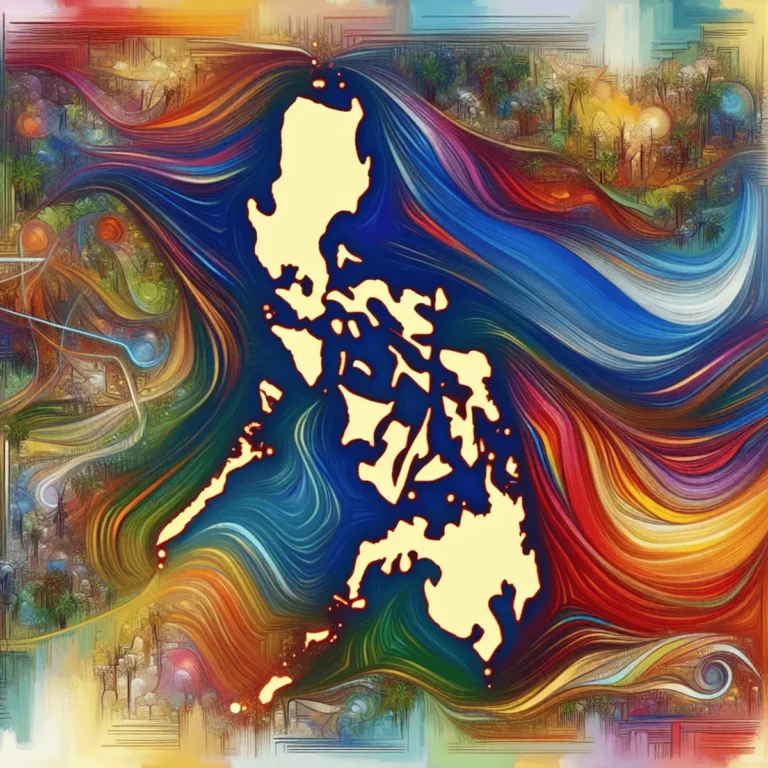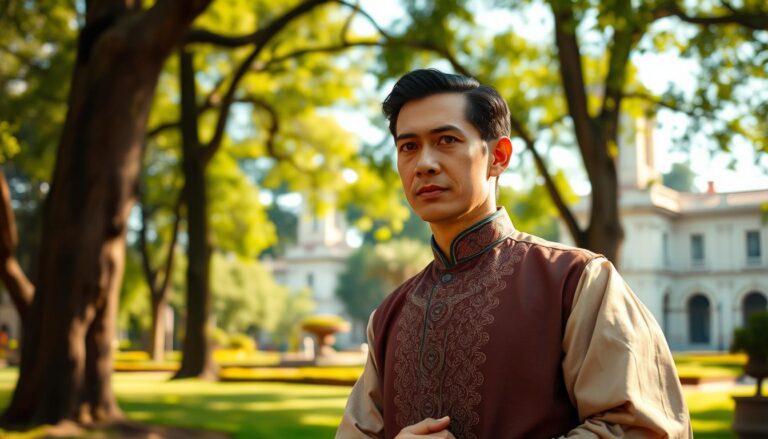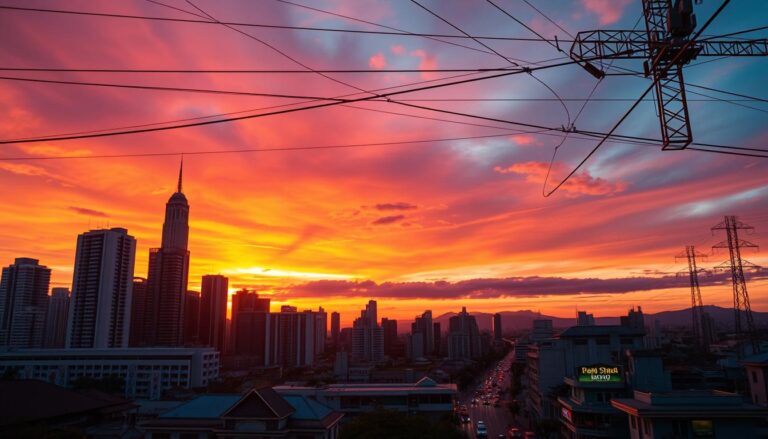Spanish Influences in Filipino Culture: A Legacy
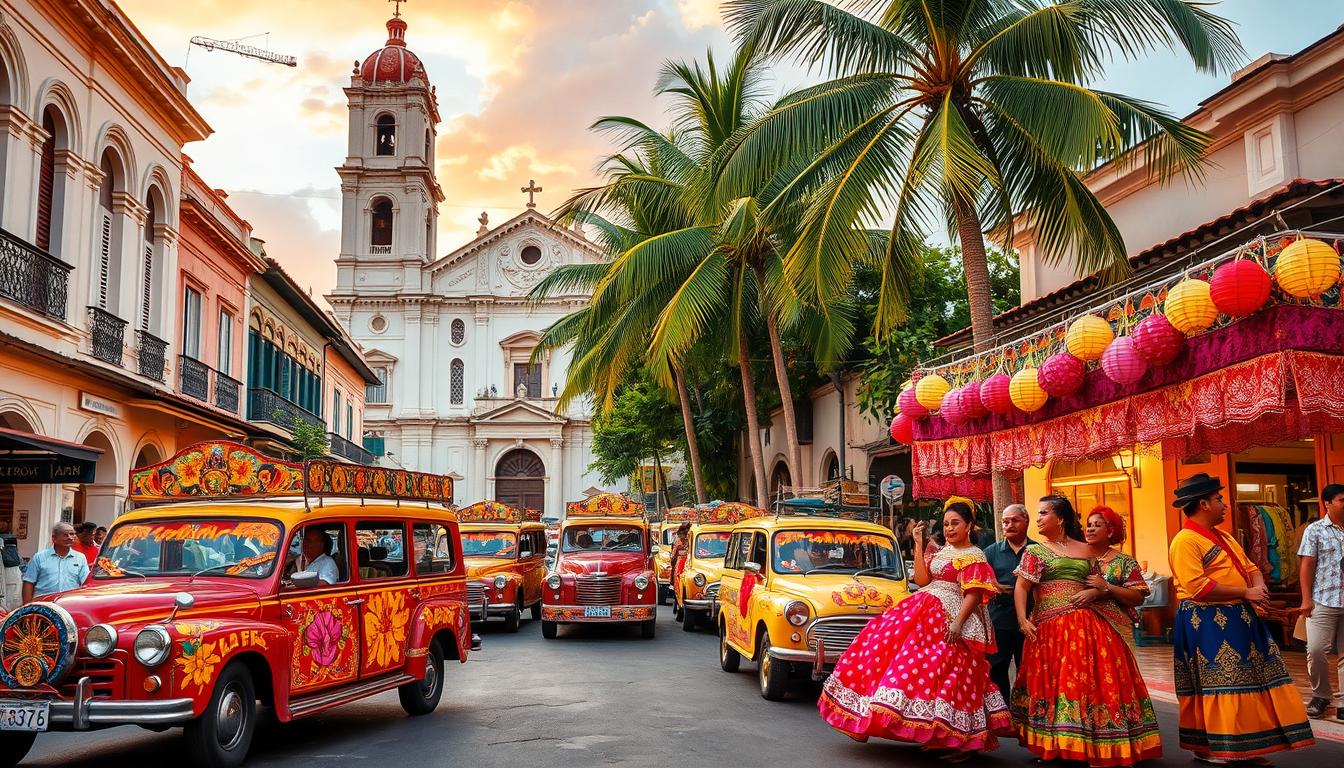
Did you know that about 20% of Tagalog words come from Spanish? This shows how deep Spanish colonization’s mark is on the Philippines, lasting over 300 years. Even though only a tiny part of the population speaks Spanish natively, less than 0.1%, its cultural impact is huge. This legacy still shapes who Filipinos are today and their traditions.
The Spanish brought more than just language. They introduced new ways of living, food, and beliefs that are still key to Filipino culture. This journey will show you how Spanish influences are woven into daily life in the Philippines.
Key Takeaways
- Only a small percentage of Filipinos identify as native Spanish speakers.
- Approximately 20% of Tagalog vocabulary comes from Spanish.
- The Spanish colonial period lasted for over 300 years, shaping Filipino customs.
- Catholicism became the dominant religion during Spanish rule.
- Spanish culinary influences introduced staples like coffee and sausage to Filipino cuisine.
- Spanish surnames were widely adopted among Filipino families during colonization.
- Despite the complexities, Spanish influences have created a rich and vibrant cultural tapestry in the Philippines.
Introduction to Spanish Colonization in the Philippines
The Spanish colonization of the Philippines started in the 16th century. Miguel López de Legazpi’s arrival began a legacy that deeply influenced Filipino culture. Manila became the capital in 1571, becoming a center for trade and culture.
Spanish rule lasted for 333 years, ending in 1898. During this time, Spaniards and local groups mixed, creating a unique culture. Spanish customs blended with local traditions, forming a rich Filipino identity.
Spanish language had a big impact on Filipino dialects. About one-third of Tagalog words come from Spanish. The Visayan language also has many Spanish words, showing the language’s wide reach.
Even though Spanish is no longer an official language since 1987, it’s still important in the Philippines. It’s the most spoken Spanish in Asia. Efforts to revive indigenous writing systems like baybayin show a cultural awakening. This highlights the complex history of Filipino culture, influenced by both colonial and indigenous elements.
Historical Background of Spanish Influence
The arrival of Spanish conquistadors in the Philippines started a new era. This era was filled with complex history. Ferdinand Magellan arrived in 1521, but Miguel López de Legazpi’s expedition in 1565 made the first lasting Spanish settlement in Cebu.
The Spanish wanted to claim land and spread Christianity. These early interactions led to big cultural changes. They showed how important Filipino cultural exchanges and new societal norms were.
Arrival of Spanish Conquistadors
The first permanent Spanish presence changed everything. Spanish rule brought new systems of governance, religion, and commerce. Catholicism became a big part of Filipino life, with over 90% of Filipinos identifying as Christian.
This deep-rooted religious influence is a lasting legacy of Spanish colonization. It has shaped the worldview and practices of Filipinos.
Establishment of Manila as the Capital
In 1571, Manila became the historical capital of the Philippines. It became a key center for trade and cultural exchange. The Manila-Acapulco Galleon Trade connected Asia with the Americas and Europe.
This trade brought economic prosperity and diverse ideas and goods. Manila became a melting pot of cultures. It helped create the rich tapestry of Filipino identity that we see today.
Spanish Influences in Filipino Culture
The Spanish rule in the Philippines left a lasting mark on our traditions and customs. It changed how we interact with each other and our families. Today, we celebrate these changes in our culture.
At cultural events and religious festivals, you can see how Spanish traditions mix with our own. This blend is a key part of who we are.
Impact on Traditions and Customs
Fiestas are a big part of Filipino life, filled with Spanish customs. These celebrations honor patron saints, showing our strong Catholic roots. Traditional music and dances, influenced by Spain, add to the fun.
These traditions are unique to the Philippines. They show how different cultures can come together.
Hispanic Cultural Assimilation
The Hispanic cultural assimilation has deeply shaped our identity. For over 300 years, Spanish culture became part of ours. This is seen in our language, with about 20% of Tagalog words coming from Spanish.
Even today, you can see Spanish influence in our daily lives. We use Spanish numerals in markets, showing how deeply it has become part of us.
Western customs changed our social ways, blending our old and new traditions. This mix is seen in how we live and learn. It’s why learning Spanish is still important today.
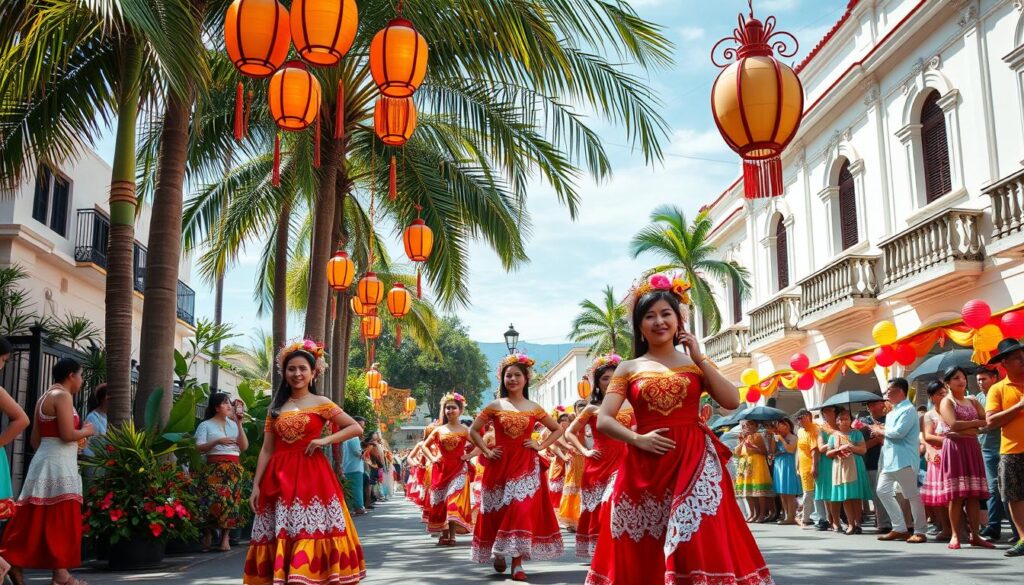
The Lingering Legacy of the Spanish Language
The Spanish language has deeply influenced Filipino dialects over the years. About 20% of Tagalog words come from Spanish. This shows the lasting impact of Spanish on our language.
Spanish words add richness to our daily conversations. They remind us of our historical ties that shape who we are today.
Integration of Spanish Vocabulary in Filipino Dialects
Spanish words and phrases are now part of many Filipino dialects. This shows how languages change and grow. Simple words like mesa (table) and silla (chair) come from Spanish.
This highlights the strong bond between Spanish and Filipino languages.
The Rise of the Chavacano Dialect
Chavacano is a Spanish-based creole born from the Philippines’ colonial past. It’s mainly spoken in Zamboanga and Cavite. This dialect mixes Spanish with local languages.
Chavacano shows the blend of Spanish and indigenous languages. It’s a living example of how language evolves with history.
Religious Influence: The Role of Catholicism
The introduction of Catholicism by Spanish missionaries greatly influenced the Philippines. It became the main religion and deeply connected with Filipino identity and society. Early meetings between Spanish missionaries and locals led to many baptisms, with priests baptizing hundreds daily.
Churches were built across the islands, changing the spiritual and physical landscape. This laid the groundwork for a big part of Filipino culture.
Introduction of Catholic Beliefs
Catholicism spread quickly, with many Filipinos converting in just a few decades. By the late 16th century, over a quarter-million Filipinos were Christians. This showed the strong impact of Spanish Catholic traditions.
The “Doctrina Christiana” in Tagalog and Spanish helped people understand and accept Christianity. This book was key in teaching faith and helped many convert, showing the success of missionary work and cultural adaptation.
Celebration of Religious Festivals
Religious festivals in the Philippines show the Catholic influence on culture. Events like Sinulog and Ati-Atihan mix Catholic traditions with local customs. These festivals bring people together and show the importance of faith in daily life.
Through parades, music, and dance, Filipino Catholic identity is celebrated. These events honor both religious and historical values, making them vital to the country’s heritage.
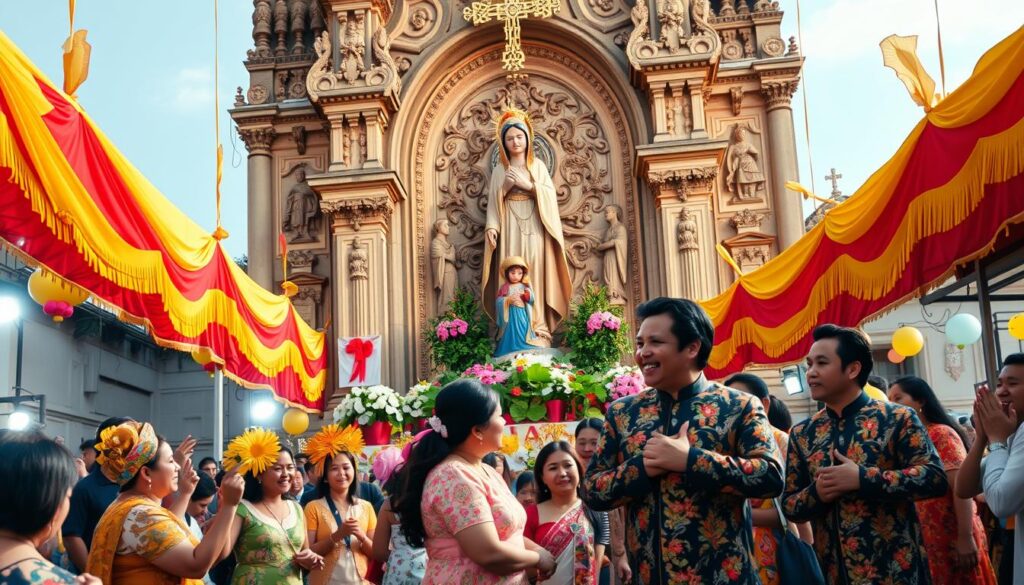
Culinary Contributions from the Spanish Colonizers
The Spanish colonization has left a lasting mark on Filipino food. Over time, they mixed local ingredients with Spanish cooking methods. This created a unique blend seen in both special dishes and everyday meals.
Adoption of Spanish Dishes in Filipino Cuisine
Filipino food has taken many Spanish dishes to heart. These dishes were once for special events but are now common. Examples include:
- Lechon – a whole roasted pig, often the centerpiece of fiestas and Christmas celebrations
- Puchero – a hearty stew made with meats and vegetables
- Paella – a signature rice dish featuring seafood or meats
- Morcon – a rolled meat dish stuffed with various fillings
- Embutido – a meatloaf enriched with local flavors
- Leche flan – a creamy caramel custard dessert
- Churros – a sweet dough pastry served with chocolate sauce
These dishes show how Spanish flavors blend with local ingredients. Even in simple homes, these dishes are made with creativity and resourcefulness.
Examples of Hispanic Foods in Daily Filipino Meals
Spanish traditions are a big part of Filipino daily meals. Ingredients like avocados and papaya are now favorites in Filipino cooking. These ingredients add depth to traditional dishes.
During Christmas, these Spanish dishes are especially popular. They highlight the lasting influence of Spanish traditions on Filipino food.
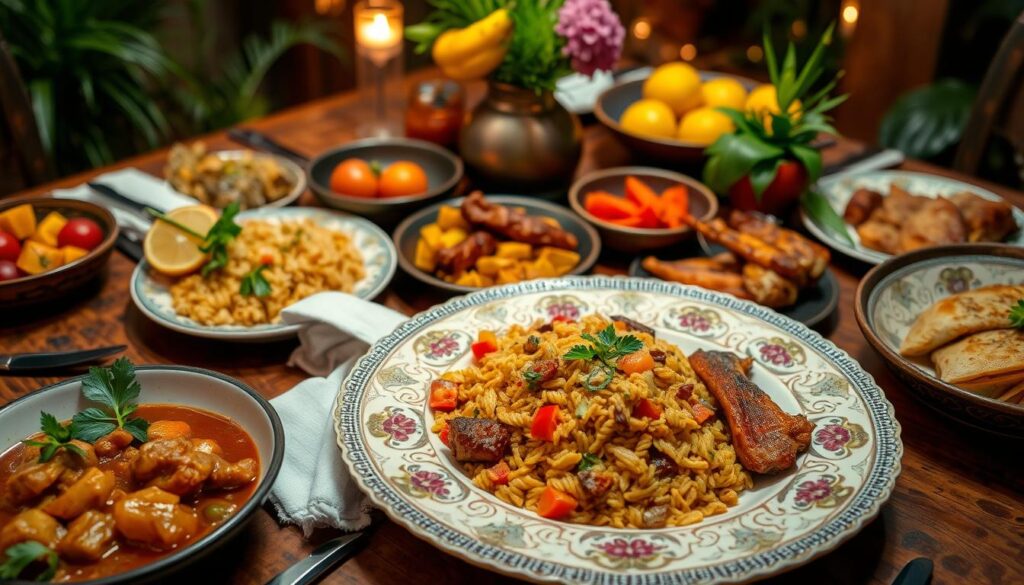
Spain’s influence on Filipino food is clear. From snacks to desserts, Spanish traditions are still celebrated. Enjoying these dishes lets you see the rich history and flavors in Filipino food today.
Spanish Architectural Styles in the Philippines
In the Philippines, you can see a mix of Spanish architectural styles that are key to the country’s identity. Historic churches and monuments are cultural landmarks, showing the lasting Spanish design influence. This influence is still felt today.
Historic Churches and Monuments
Historic churches are a big part of the Philippines’ story, thanks to Spanish colonization. San Agustin Church in Manila is a UNESCO World Heritage Site. It shows how European styles mixed with local skills.
The St. Augustine Church in Paoay is another example. It shows how Filipino architects adapted Spanish styles. These churches are not just for worship. They also hold cultural heritage.
Impact on Urban Planning and Design
Spanish architecture shaped urban planning in the Philippines. Manila’s grid layout, set during colonial times, highlights public spaces and plazas. This design encouraged community interaction.
This approach to urban planning reflected Spanish tastes but also influenced Filipino life. Today, designs still blend historical influences with modern needs.

Spanish Naming Traditions and Surnames
In the Philippines, Spanish naming traditions have deeply influenced the culture. They have created a unique mix of identities through family names. The system is simple: [personal name(s)] [mother’s paternal family name] [father’s paternal family name]. This shows the lasting impact of Spanish colonization, which lasted from 1565 to 1898.
Many Filipino surnames like Santos, Reyes, Cruz, and Garcia show Spanish roots. In 2018, names like Nathaniel, James, Althea, and Samantha were popular. But now, English names are becoming more common, showing a shift in culture.
Honorific titles and family terms are key in Filipino communication. They show respect and social order. Terms like Lolo, Lola, Tito, and Tita are used to connect generations.
Also, nicknames are common in the Philippines. They come from interests, family, or looks. This shows how close-knit Filipino society is, where nicknames bring people together.
The mix of cultures, including Chinese ancestry, makes Filipino heritage rich. The blend of Spanish naming with local customs has shaped a unique identity. This identity is still growing today.
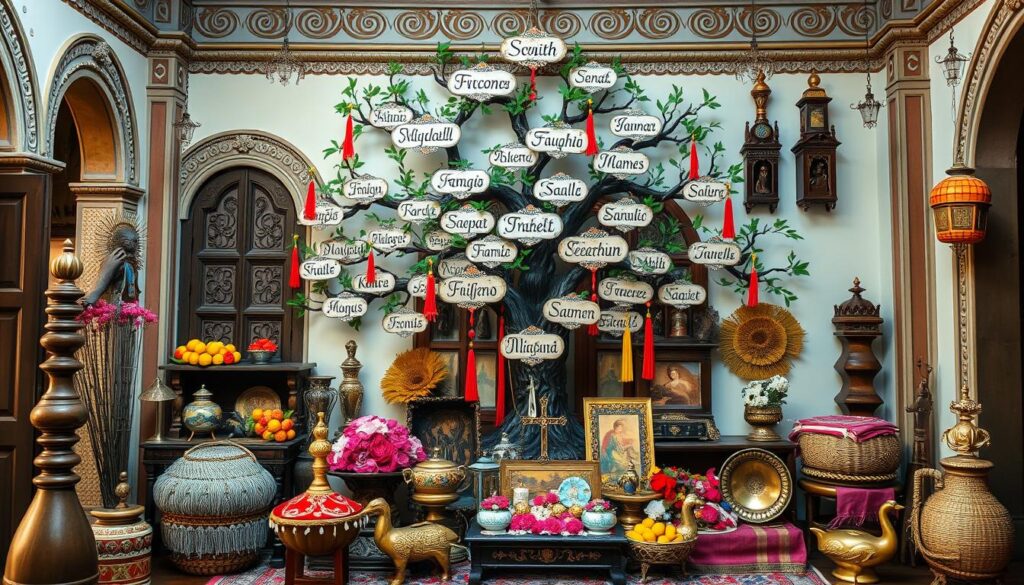
The Socio-Political Impact of Spanish Rule
Spanish rule in the Philippines shaped the country’s governance and social order for over 300 years. It created a social hierarchy with Spanish elites at the top, followed by mestizos, and indigenous people at the bottom. This structure has had lasting effects on Filipino society and politics.
Creation of a Colonial Social Structure
The impact of Spanish rule on the Philippines’ social hierarchy was profound. The encomienda system introduced a strict structure that governed society and resource access. It categorized various groups, leading to deep social stratification.
This colonial structure still influences modern Filipino society, affecting education and economic opportunities. It created identity among groups but also laid the groundwork for ongoing inequality.
Spanish Influence on Governance and Law
Spanish rule transformed governance and law in the Philippines. A centralized government replaced the barangay system of independent villages. The Spanish legal system was introduced, shaping the country’s judicial and penal codes.
Laws from Spanish times still influence today’s politics. They affect legal practices and the preferences of political leaders. Statutes from this era are still used, linking Spanish rule to today’s governance.
| Social Hierarchy Level | Group | Characteristics |
|---|---|---|
| 1 | Spanish Elites | Held political power, land ownership, and social status. |
| 2 | Mestizos | Mixed heritage, often held skilled professions and managed some economic opportunities. |
| 3 | Indigenous Populations | Constrained by colonial policies and faced social and economic disadvantages. |
The legacy of Spanish colonialism still shapes governance and social structure in the Philippines. Understanding this history is key to addressing social imbalances and moving towards a more inclusive future.
Hispanic Influence on Filipino Art and Literature
The Spanish culture has deeply influenced Filipino art and literature. This mix of traditions shapes the country’s cultural story. The shift from oral to written forms during Spanish rule was key in shaping today’s literature.
The Spanish influence is clear in the themes and styles used in Filipino literature. Writers blend indigenous and Hispanic stories, creating unique tales. The first book printed in the Philippines, “Doctrina Christiana,” shows how Spanish missionaries helped start Philippine literature.
Integration of Spanish Themes in Literature
Filipino authors mix Spanish themes into their stories. This creates a rich mix of cultural experiences. Writers, influenced by Spanish styles, include social, political, and religious themes.
The first book in the Philippines, “Doctrina Christiana,” was printed in 1593. It shows how Spanish missionaries helped start Philippine literature. They introduced new ways of expressing stories, blending local and Spanish traditions.
Impact on Visual Arts in the Philippines
Spanish influence on art is also significant. The art from the colonial era is a mix of religious iconography and modern styles. Famous colonial churches are filled with religious paintings and sculptures.
Local artisans, using Spanish techniques, helped create a vibrant art scene. This scene is a blend of indigenous and Spanish influences. It shows the unique cultural expression in the Philippines.
The growth of sculpture, painting, and decorative arts reflects the country’s history. Art movements took elements of Spanish styles while keeping local traditions. This led to stunning artworks that show cultural pride.
This evolution highlights the artistic talent in the Philippines. It also shows the lasting impact of Spanish influence on Filipino art.
| Art Form | Spanish Influence | Local Adaptations |
|---|---|---|
| Sculpture | Religious imagery and saints | Indigenous motifs and local materials |
| Painting | Portraits and landscapes in Spanish styles | Incorporation of local themes and colors |
| Architecture | Baroque style churches | Use of local materials and designs |
| Literature | Poetic forms and themes | Blending of indigenous tales with Hispanic narratives |
Exploring Filipino art and literature shows the deep Spanish influence. This heritage is not just a reminder of colonization but also inspires artists and writers today.
Enduring Spanish Influence on Filipino Festivals
The Philippines’ festivals show the lasting effect of Spanish rule on its culture. Fiestas and processions mix Catholic traditions with local customs. This blend shows the unique mix of beliefs and practices in the Philippines.
These events are key for community bonding. They let Filipinos celebrate their heritage while keeping their identity.
Fiestas and Processions: A Cultural Blend
Filipino festivals are filled with joyous fiestas and colorful processions. They honor patron saints with music and rituals. The Sinulog Festival in Cebu is a great example of this mix.
This blend creates a lively atmosphere. It brings people together for worship and fun. It shows the importance of shared experiences in Filipino culture.
Celebrating Patron Saints and Indigenous Beliefs
The celebration of patron saints shows the mix of Spanish and local beliefs. Festivals like the Feast of the Santo Niño highlight this. They show how faith and heritage come together.
These events let communities express their devotion. They also help keep traditions alive. This shows how festivals are key in preserving Filipino culture.
| Festival Name | Location | Patron Saint | Cultural Significance |
|---|---|---|---|
| Sinulog Festival | Cebu City | Santo Niño | A celebration of the Filipino people’s history and a dance ritual honoring the child Jesus, blending local and Catholic traditions. |
| Pahiyas Festival | Lucban, Quezon | Santo Isidro Labrador | A showcase of local agricultural products and artistic displays, symbolizing gratitude for a bountiful harvest. |
| Ati-Atihan Festival | Kalibo, Aklan | Sto. Niño | Honors the Santo Niño through street dancing and vibrant costumes, with roots in indigenous practices. |
These festivals show how Filipino culture thrives. They mix Spanish and indigenous beliefs. Through fiestas and processions, we see the rich culture of the Philippines today.
Modern-Day Reflections of Spanish Influence
The Spanish legacy still shapes modern Filipino identity. Today’s culture shows the lasting impact of Spanish on language, food, and traditions. This shows how history influences today’s Filipino customs, creating a unique heritage.
Spanish Impact on Filipino Identity
Even though few speak Spanish, it’s still a big part of Filipino identity. About 20% to 30% of Tagalog words come from Spanish. Chavacano, a mix of Spanish and local languages, is spoken by 600,000 people mainly in Zamboanga City.
This shows how Spanish influence is still strong in Filipino culture.
Continued Relevance of Spanish Practices
Many Spanish customs are still celebrated in the Philippines. This connects the past to the present. Traditional Spanish dishes are part of Filipino food, showing the lasting impact of Spanish cuisine.
Religious festivals and rituals also show a deep respect for heritage. As more young Filipinos learn Spanish, cultural conversations become more lively.
Conclusion
Exploring Spanish influence in the Philippines reveals a rich cultural tapestry. For 333 years, Spanish rule shaped many aspects of life. This includes language, religion, food, and social structures.
Popular dishes like adobo show this lasting impact. Spanish words still add flavor to our daily talks.
The arrival of Catholicism changed the Philippines’ spiritual landscape. It linked faith and identity deeply. While Islam stayed strong in places like Mindanao, Catholicism spread widely.
This mix of beliefs shaped personal and community faiths. It also influenced social norms that still exist today.
Looking back, Spanish rule brought new ways of owning land and farming. It also introduced education. The mix of Spanish and American cultures defines Filipino identity today.
Understanding this history is key to grasping Filipino heritage. It enriches our knowledge of who we are today.



